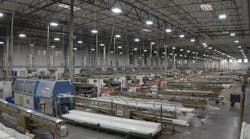It's easy to overlook gradual change when you’re in the thick of it. That was the case for a manufacturing plant, where our client’s first-generation LED lighting system had slipped under the radar. Their lights had dimmed to 50% of their original intensity without anyone really noticing.
When my team at PNW Energy Group walked into VISION Extrusions Group’s facility, we immediately knew we needed to find them a solution to make it brighter, get more productivity, and result in less maintenance —all while finding a utility rebate. And it needed to happen quickly. The poor lighting levels posed a risk to the well-being of the employees and complicated their task of ensuring product quality.
The solution? Luminaire Level Lighting Controls (LLLCs). After speaking with their local utility, Snohomish County PUD, we decided that LLLC was the best choice for their facility. LLLCs create great opportunities for customers to take advantage of utility rebates and also reduce their energy load. With a generous incentive from Snohomish County PUD, the facility got better light at the same wattage and an unprecedented level of control.
To make it happen, we worked closely with the person who knew the company and its 122,000-square-foot facility the best: the facility manager, Rusty Fenrich.
VISION Extrusions Group makes specialized building products like custom-sized doors and windows. Their company ethos is based on a sustainable approach to technologies that recycle and preserve natural resources. But while Fenrich had a green mission, he was also on a budget and tight timeline. His initial plan was to simply replace the existing LED fixtures, but a design that included LLLCs could get the project done just as fast.
LLLCs are straightforward and easy to install. It not only provides ideal lighting quality but also optimizes it, automatically adjusting lighting output in unoccupied areas. This advanced networked lighting control system integrates both sensors and load controllers into each fixture, providing unparalleled flexibility, control, deep energy savings, and a great lighting experience.
We worked with Snohomish County PUD, to secure $43,000 in rebates, which covered 86% of the capital costs. It supported the installation of 181 high bays and 109 troffers with the set of specific controls that were needed.
As told in a new case study by BetterBricks, a commercial resource of the Northwest Energy Efficiency Alliance, this has resulted in an annual saving of 112,000kWh and roughly $10,115 in annual electrical savings.
Poor lighting can cause many issues for employees, including workplace accidents and reduced productivity. Our specification of LLLCs was rooted in safety and efficiency, and that’s why along with improving the facility’s lighting environment came enhanced safety measures. Now, employees have brighter lighting while working in the facility, creating a safer and more productive work environment.
Additionally, so that the client doesn’t get lost again in the daily hustle of a manufacturing plant, we delivered them a system that requires virtually zero maintenance. If Rusty or someone on his team needs to adjust something in the future, they can do so simply with the touch of an app.
My team was forever changed by this project at VISION Extrusions Group, because it showed us just how much money and energy savings LLLCs bring. We’ve been using LLLCs as a primary lighting system solution in our retrofit work since. It’s a futureproofed investment for our clients that give them smart and flexible systems, getting the light right, for years to come.




